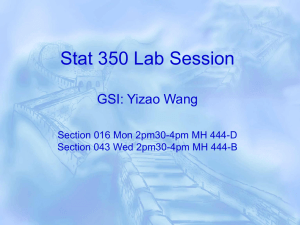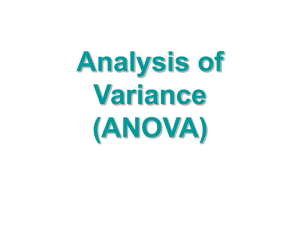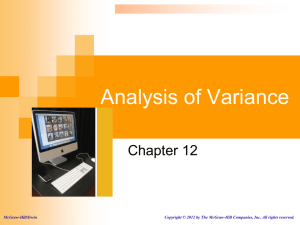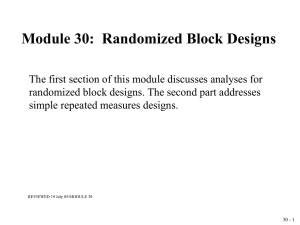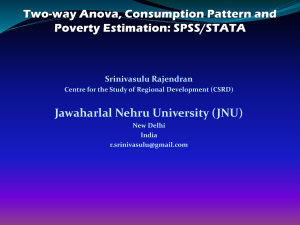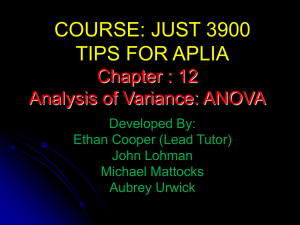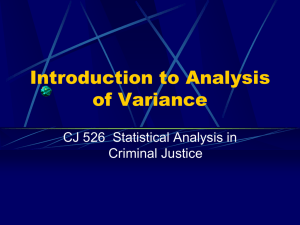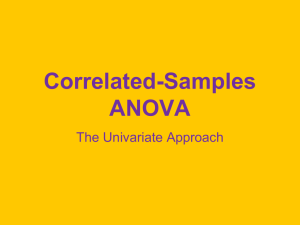ANOVA
advertisement
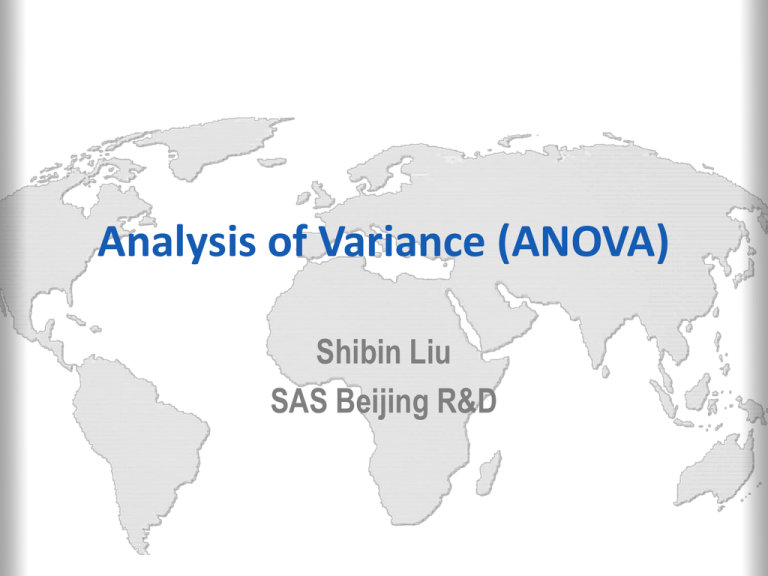
Analysis of Variance (ANOVA) Shibin Liu SAS Beijing R&D Agenda • • • • • • • 2 0. Lesson overview 1. Two-Sample t-Tests 2. One-Way ANOVA 3. ANOVA with Data from a Randomized Block Design 4. ANOVA Post Hoc Tests 5. Two-Way ANOVA with Interactions 6. Summary Agenda • • • • • • • 3 0. Lesson overview 1. Two-Sample t-Tests 2. One-Way ANOVA 3. ANOVA with Data from a Randomized Block Design 4. ANOVA Post Hoc Tests 5. Two-Way ANOVA with Interactions 6. Summary Lesson overview One sample t-Test μ 4 μ0 Lesson overview Two-sample t-Test μ1 5 ≠ μ2 Lesson overview ANOVA μ1 6 ≠ μ2 ≠ μ3 Lesson overview ANOVA Response Variable Predictor Variable Levels 7 Lesson overview ANOVA Response Variable 8 Predictor Variable Predictor Variable Lesson overview One sample t-Test Two-sample t-Test ANOVA 9 Lesson overview What do you want to examine? Descriptive Statistics Inferential Statistics The location, spread, and shape of the data’s distribution The difference between groups on one or more variables Summary statistics or graphics? How many groups? Summary statistics Both The relationship between variables Which kind of variables? Categorical response variable Continuous only Two Two or more SUMMARY STATISTICS DISTRIBUTION ANALYSIS Descriptive Statistics Descriptive Statistics, histogram, normal, probability plots CORRELATIONS TTEST ONE-WAY FREQUENCIES & TABLE ANALYSIS Frequency tables, chi-square test LINEAR MODELS LINEAR REGRESSION LOGISTIC REGRESSION Analysis of variance Lesson 1 10 Lesson 2 Lesson 3 & 4 Lesson 5 Agenda • 0. Lesson overview • • • • • • 11 1. Two-Sample t-Tests 2. One-Way ANOVA 3. ANOVA with Data from a Randomized Block Design 4. ANOVA Post Hoc Tests 5. Two-Way ANOVA with Interactions 6. Summary The Two-Sample t-Test: Introduction μ1 12 ≠ μ2 The Two-Sample t-Test: Introduction Salary ? Blood pressure? …… 13 The Two-Sample t-Test: Introduction In this topic, we will learn to do the following: – Analyze differences between two population means using the t-Test task – Verify the assumption of and perform a two-sample t-Test – perform a one-sided t-Test 14 The Two-Sample t-Test: Introduction Two-Sample t-Test H0: μ1 = μ2 H0: μ1 - μ2 =0 Two-Sample t-Test Ha : μ 1 ≠ μ 2 Ha : μ 1 - μ 2 ≠ 0 15 Two-Sample t-Tests: Assumptions Before we start the analysis, examine the data to verify that the statistical assumption are valid: – Independent observations: No information provided by other observations No impact between the observations – Normally distributed data for each group – Equal variances for each group. 16 𝜎12 =𝜎22 Two-Sample t-Tests: F-Test for Equality of Variance F-Statistic H0: 𝜎12 =𝜎22 H1: 𝜎12 ≠ 𝜎22 max(𝑠12 , 𝑠22 ) 𝐹= m𝑖𝑛(𝑠12 , 𝑠22 ) When the null hypothesis is true, what value will the F-Statistic be close to? 17 𝐹≅1 𝐹 = large value Two-Sample t-Tests: Examining the Equal Variance t-Test and p-Values ? F-Test for Equal Variance H0: 𝜎12 =𝜎22 0.7446 18 > 0.05 Two-Sample t-Tests: Examining the Equal Variance t-Test and p-Values 𝜎12 =𝜎22 0.0003 H0: μ1 - μ2 =0 19 Ha : μ 1 - μ 2 ≠ 0 < 0.05 Two-Sample t-Tests: Examining the Unequal Variance t-Test and p-Values ? F-Test for Equal Variance H0: 𝜎12 =𝜎22 0.0185 20 < 0.05 Two-Sample t-Tests: Examining the Unequal Variance t-Test and p-Values 𝜎12 ≠ 𝜎22 0.0320 H0: μ1 - μ2 =0 21 Ha : μ 1 - μ 2 ≠ 0 < 0.05 Two-Sample t-Tests: Demo Scenario: compare two group’s means, girl’s and boy’s SAT scores Identify the data TestScores Classification variable? Continuous variable to analyze? 22 Two-Sample t-Tests: Demo Analyze > ANOVA > t Test 23 Two-Sample t-Tests: Demo Result interpreting: 24 Normal? Two-Sample t-Tests: Demo Result interpreting 25 Normal? Two-Sample t-Tests: Demo Result interpreting H0: μ1 - μ2 =0 H0: 𝜎12 =𝜎22 26 Two-Sample t-Tests: Demo Result interpreting The confidence interval for the mean difference (-3.6950, 125.2) includes 0. this implies that you cannot say with 95% confidence that the difference between boys and girls is not zero. Therefore, it also implies that the p-value is greater than 0.05. 27 Two-Sample t-Tests: One-Sided Tests Two-sample t-Test Ha : μ 1 ≠ μ 2 Ha : μ 1 > μ 2 New drug only have positive effect Ha: μ1 −μ2 < 0 One-Sided Test 28 Two-Sample t-Tests: One-Sided Tests One-Sided Test One-Sided Test H0: μ1 ≤ μ2 H0: μ1 ≥ μ2 One direction 29 One direction Two-Sample t-Tests: One-Sided Tests One-Sided Test μ1 > μ2 HH00:: equality Ha : μ 1 < μ 2 Critical region 30 Two-Sample t-Tests: One-Sided Tests One-Sided Test μ1 > μ2 HH00:: equality Ha : μ 1 < μ 2 What is Power? Power is the probability when your test will reject the null hypothesis when the hypothesis is false. 31 Or the probability when you detect a difference when the difference actually exists. Two-Sample t-Tests: One-Sided Tests/Scenario one-sided upper-tailed t-test SAT Scores Group 1 H0: μ1 −μ2 ≤ 0 32 > SAT Scores Group 2 Ha: μ1 −μ2 > 0 Two-Sample t-Tests: One-Sided Tests/Scenario one-sided upper-tailed t-test t statistic H0: μ1 −μ2 ≤ 0 33 Ha: μ1 −μ2 > 0 Two-Sample t-Tests: One-Sided Tests/Scenario Analyze > ANOVA > t Test > Two sample > Preview Code> Insert code 34 Two-Sample t-Tests: One-Sided Tests/Scenario 0.0321< 0.05 0 is not in the interval 35 Two-Sample t-Tests Question 1. What justifies the choice of a one-sided test versus a two-sided test a) b) c) d) The need for more statistical power Theoretical and subject-matter considerations The non-significance of a two-sided test The need for an unbiased test statistic Answer: b 36 Two-Sample t-Tests Question 2. A professor suspects her class is performing below the department average of 73%. She decides to test this claim. Which of the following is the correct alternative hypothesis? a) μ < 0.73 b) μ > 0.73 c) μ ≠ 0.73 Answer: a 37 Agenda • 0. Lesson overview • 1. Two-Sample t-Tests • • • • • 38 2. One-Way ANOVA 3. ANOVA with Data from a Randomized Block Design 4. ANOVA Post Hoc Tests 5. Two-Way ANOVA with Interactions 6. Summary One-Way ANOVA: Introduction ANOVA μ1 39 ≠ μ2 ≠ μ3 One-Way ANOVA: Objective • Analyze difference between population means using the Linear Models task • Verify the assumption of analysis variance. 40 One-Way ANOVA: ANOVA overview One-way ANOVA Response Variable Predictor Variable Levels 41 One-Way ANOVA: ANOVA overview Case 1 Response Variable Programmer earns more than teacher? salary Programmer 42 Predictor Variable Job title Teacher One-Way ANOVA: ANOVA overview Case 1 Two-sample t-Test Programmer Teacher Predictor Variable 43 One-Way ANOVA: ANOVA overview Case 1 One-way ANOVA F statistic = Programmer Teacher Predictor Variable 44 2 Two-sample t statistict-Test One-Way ANOVA: ANOVA overview Case 2 Response Variable T-cell counts Predictor Variable Medication 1 45 Medication 2 Placebo One-Way ANOVA: ANOVA overview Case 2 Two-sample t-Test Placebo Medication 1 Medication 2 Medication 2 Placebo 46 Medication 1 One-Way ANOVA: ANOVA overview Case 2 One-way ANOVA Placebo Medication 1 Medication 2 47 One-Way ANOVA: The ANOVA Hypothesis Small difference ANOVA H0: μ 1 = μ 2 = μ 3 = μ 4 48 One-Way ANOVA: The ANOVA Hypothesis ANOVA H0: μ1 = μ2 = μ3 Medication 1 Predictor Variable Placebo Medication 2 49 One-Way ANOVA: The ANOVA Hypothesis ANOVA Ha0: μ11 = μ22 ≠ = μμ33 Medication 1 Predictor Variable Placebo Medication 2 different 50 One-Way ANOVA: The ANOVA model Error term i: indexes treatments (three types of medication) K: observation number μ: overall population mean effect τ1 =μ1 - μ τ2 =μ2 - μ τ3 =μ3 - μ 51 One-way ANOVA One-Way ANOVA: Sums of Squares H0: μ1 = μ2 = μ3 Variability between groups By ratio 52 > Variability within groups By ratio One-Way ANOVA: Sums of Squares 53 One-Way ANOVA: Sums of Squares Variability between groups Total variability SST SST =∑ ∑ (𝑌𝑖𝑗 − 𝑌)2 SSM =∑ 𝑛𝑖 (𝑌𝑖 − 𝑌)2 SSE =∑ ∑ (𝑌𝑖𝑗 − 𝑌𝑖 )2 54 = Variability within groups SSM + SSE Total Sum of Squares Model Sum of Squares Error Sum of Squares One-Way ANOVA: F statistic F statistic and Critical Value at α=0.05 SSM 𝑑𝑓 F(Model df, Error df)= MSM / MSE= SS E 𝑑𝑓 𝑀 𝐸 MSM : Model Mean Square MSE : Error Mean Square In general, degree of freedom (DF) can be thought of as the number of independent pieces of information. 1. Model DF is the number of treatment minus 1. 2. Corrected total DF is the sample size minus 1. 3. Error DF is the sample size minus the number of treatments (or the difference between the corrected total DF and the Model DF) 55 One-Way ANOVA: Coefficient of Determination Coefficient of Determination: 𝑺𝑺𝑴 2 R= 𝑺𝑺𝑻 “proportion of variance accounted for by the model ” 56 One-Way ANOVA: Assumptions for ANOVA Assumptions for ANOVA 1. Independent observations 2. Error terms are normally distributed 3. Error terms have equal variances Assessing ANOVA Assumptions 1. 2. 3. 57 Good data collection methods help ensure the independence assumption. Diagnostic plots can be used to verify the assumption that the error is approximately normally distributed The Linear Models task can produce a test of equal variance. H0 for this hypothesis test is that the variances are equal for all populations. One-Way ANOVA: Predicted and Residual values Estimates of the error term Observation 58 - Group mean = Residuals One-Way ANOVA: Predicted and Residual values + The predicted value in ANOVA is the group mean. A residual is the difference between the observed value of the response and the predicted value of the response variable. 59 One-Way ANOVA: Scenario: Comparing Group Means with One-Way ANOVA Garlic 60 Response Variable Predictor Variable Bulb Weight Fertilizer One-Way ANOVA: Scenario: Comparing Group Means with One-Way ANOVA ANOVA H0: μ1 = μ2 = μ3 = μ4 Ha: at least one is different 61 One-Way ANOVA: Scenario: Comparing Group Means with One-Way ANOVA Description check of MGGARLIC > Summary Statistic 62 One-Way ANOVA: Question 1. You have 20 observations in you ANOVA and you calculate the residuals. What will they sum to? a) b) c) d) e) -20 20 400 0 Need more information Answer: d 63 One-Way ANOVA: Question 2. Which of the following phrases describes the model sums of squares, or SSM? a) The variability between the groups b) The variability within the groups c) The variability explained by the error terms Answer: a 64 One-Way ANOVA: Question 3. Match the null hypothesis to the correct SAS output a) b H0: 𝜎12 = 𝜎22 a H0: μ1 = μ2 65 b) One-Way ANOVA: Scenario: Comparing Group Means with One-Way ANOVA Task> ANOVA>Linear Models, with MGGARLIC data 66 One-Way ANOVA: Scenario: Comparing Group Means with One-Way ANOVA Task> ANOVA>Linear Models 67 One-Way ANOVA: Summary Null Hypothesis: Alternative Hypothesis: All means are equal at least one mean is different 1. Produce descriptive statistics. 2. Verify assumptions. • Independence • Normality • Equal variance 3. Examine the p-value in the ANOVA table. If the p-value is less than alpha, reject the null hypothesis. 68 Agenda • • • • • • • 69 0. Lesson overview 1. Two-Sample t-Tests 2. One-Way ANOVA 3. ANOVA with Data from a Randomized Block Design 4. ANOVA Post Hoc Tests 5. Two-Way ANOVA with Interactions 6. Summary ANOVA with Data from a Randomized Block Design: Introduction Brands age Medication 1 Medication 2 70 Placebo ANOVA with Data from a Randomized Block Design: Introduction Over 50 30-50 Under30 71 ANOVA with Data from a Randomized Block Design: Objective • Recognize the difference between a completely randomized design and a randomized block design. • Differentiate between observed data and designed experiments. • Use the Linear Models task to analyze data from a randomized block design 72 ANOVA with Data from a Randomized Block Design: Observational Studies Groups can be naturally occurring. Gender and ethnicity Random assignment might be unethical or untenable Smoking or credit risk groups In Observational or Retrospective studies, the data values are observed as they occur, not affected by an experimental design. 73 ANOVA with Data from a Randomized Block Design: Controlled Experiments 1. Random assignment might be desirable to eliminate selection bias. 2. You often wan to look at the outcome measure prospectively. 3. You can manipulate the factors of interest and can more reasonably claim causation. 4. You can design your experiment to control for other factors contributing to the outcome measure. 74 ANOVA with Data from a Randomized Block Design Question 3. Can you determine a cause-and–effect relationship in an observational study? a) Yes b) No Answer: b observational study 75 controlled study In an observational study, you often examine what already occurred, and therefore have little control over factors contributing to the outcome. In a controlled experiment, you can manipulate the factors of interest and can more reasonably claim causation. ANOVA with Data from a Randomized Block Design: Nuisance Factors Nuisance Factors are factors can affect the outcome but are not of interest in the experiment. T-Cell Count Medication Age Age Randomized block design 76 ANOVA with Data from a Randomized Block Design Question 4. Which part of the ANOVA tables contains the variation due to nuisance factors? a) Sum of Squares Model b) Sum of Squares Error c) Degrees of Freedom Answer: b 77 ANOVA with Data from a Randomized Block Design: Including a Blocking Variable in the Model Age 78 ANOVA with Data from a Randomized Block Design: Including a Blocking Variable in the Model Age 79 ANOVA with Data from a Randomized Block Design: More ANOVA Assumptions ANOVA The treatment are randomly assigned to each block Independent observations Under30 30-50 Normally distributed data Equal variances No interaction 80 Over 50 ANOVA with Data from a Randomized Block Design Scenario: Creating a Randomized Block Design Garlic H0: μ1 = μ2 = μ3 = μ4 Ha: at least one is different Sun What’s the nuisance factors in this case PH level of soil Rain 81 ANOVA with Data from a Randomized Block Design Scenario: Creating a Randomized Block Design Sun Bulb Weight fertilizer PH of the soil Rain 82 ANOVA with Data from a Randomized Block Design Scenario: Creating a Randomized Block Design Randomized block design 83 ANOVA with Data from a Randomized Block Design Scenario: Creating a Randomized Block Design 84 ANOVA with Data from a Randomized Block Design Question 5. In a block design, Which part of the ANOVA tables contains the variation due to nuisance factors? a) Sum of Squares Model b) Sum of Squares Error c) Degrees of Freedom Answer: a 85 ANOVA with Data from a Randomized Block Design: Performing ANOVA with Blocking Task> ANOVA>Linear Models, with MGGARLIC_BLOCK data 86 ANOVA with Data from a Randomized Block Design: Performing ANOVA with Blocking Task> ANOVA>Linear Models, with MGGARLIC_BLOCK data 87 ANOVA with Data from a Randomized Block Design My groups are different. What next? – The p-value for Fertilizer indicates you should reject the H0 that all groups are the same. – From which pairs of fertilizers, are garlic bulb weights different from one another? – Should you go back and do several t-tests? 88 Agenda • • • • 0. Lesson overview 1. Two-Sample t-Tests 2. One-Way ANOVA 3. ANOVA with Data from a Randomized Block Design • 4. ANOVA Post Hoc Tests • 5. Two-Way ANOVA with Interactions • 6. Summary 89 ANOVA Post Hoc Tests: Introduction μ1 One-way ANOVA μ2 Randomized block design μ3 90 μ? ANOVA Post Hoc Tests: Introduction μ1 Pairwise test H0: μ1 = μ2 Pairwise test H0: μ1 = μ3 P-value Pairwise test H0: μ2 = μ3 P-value P-value μ? μ2 μ3 ANOVA Post Hoc Tests 91 Multiple Comparison Method Type I error Type I error ANOVA Post Hoc Tests: Multiple Comparison Methods Question 7. With a fair coin, your probability of getting heads on one flip is 0.5. if you flip a coin and got heads, what is the probability of getting heads on the second try? a) b) c) d) e) 0.5 0.25 0.00 1.00 0.75 Answer: a 92 ANOVA Post Hoc Tests: Multiple Comparison Methods Question 8. With a fair coin, your probability of getting heads on one flip is 0.5. If you flip a coin twice, what is the probability of getting at least one head out of two? a) b) c) d) e) 0.5 0.25 0.00 1.00 0.75 Answer: e 93 ANOVA Post Hoc Tests: Multiple Comparison Methods Pairwise Type I Error t-test H0: μ1 = μ2 H0 : μ 1 = μ 3 α=0.05 94 H0: μ2 = μ3 ANOVA Post Hoc Tests: Multiple Comparison Methods Comparisonwise Error Rate Number of Comparisons 0.05 1 0.05 0.05 3 0.14 0.05 6 0.26 0.05 10 0.40 𝐸𝐸𝑅 = 1 − (1 − 𝛼)𝑛𝑐 Type I Error Pairwise t-test 95 Experimentwise Error Rate nc: Number of comparisons ANOVA Post Hoc Tests: Tukey's Multiple Comparison Method Tukey Method EER H0: μ1 = μ2 H0: μ1 = μ3 H0: μ2 = μ3 96 Pairwise comparisons ANOVA Post Hoc Tests: Tukey's Multiple Comparison Method Tukey Method H0: μ1 = μ2 97 EER<0.05 EER=0.05 H0: μ1 = μ3 Pairwise comparisons ANOVA Post Hoc Tests: Tukey's Multiple Comparison Method This method is appropriate when you consider pairwise comparisons only. The Experimentwise Error Rate is: – Equal to alpha when all pairwise comparisons are considered – Less than alpha when fewer than all pairwise comparisons are considered 98 ANOVA Post Hoc Tests: scenario: determine which mean is different Garlic Ha: at least one is different Fertilizers: three organics, one control 99 ANOVA Post Hoc Tests: Diffograms and the Tukey Method Difference between the means least square mean by least square mean 100 Equality of the means ANOVA Post Hoc Tests: Diffograms and the Tukey Method Is there the diff between the treatments 1 and 2? 101 Can you identify the pairwise comparisons that do not have significant diff means? ANOVA Post Hoc Tests: Dunnett's Multiple Comparison Method Special Case of Comparing to a Control Comparing to a control is appropriate when there is a natural reference group, such as a placebo group in a drug trial. – Experimentwise Error Rate is no greater than the stated alpha – Comparing to a control takes into account the correlations among tests – One-sided hypothesis test against a control group can be performed – Control comparison computes and tests k-1 GroupWise differences, where k is the number of levels of the classification variable. – An example is the Dunnett method 102 ANOVA Post Hoc Tests: Control Plots and the Dunnett Method Upper decision limit Lower decision limit 103 ANOVA Post Hoc Tests: Performing a Post Hoc Tests 104 ANOVA Post Hoc Tests: Performing a Post Hoc Tests: Turkey 105 ANOVA Post Hoc Tests: Performing a Post Hoc Tests: Dunnett 106 ANOVA Post Hoc Tests: Performing a Post Hoc Tests: t-test 107 Agenda • • • • • 0. Lesson overview 1. Two-Sample t-Tests 2. One-Way ANOVA 3. ANOVA with Data from a Randomized Block Design 4. ANOVA Post Hoc Tests • 5. Two-Way ANOVA with Interactions • 6. Summary 108 Two-Way ANOVA with Interactions: Introduction One-way ANOVA μ1 109 ≠ μ2 ≠ μ3 Two-Way ANOVA with Interactions: Introduction One-way ANOVA Response Variable Predictor Variable Levels 110 Two-Way ANOVA with Interactions: Introduction ANOVA Two-way ANOVA Response Variable 111 Predictor Variable Predictor Variable Levels Levels Two-Way ANOVA with Interactions: Introduction Two-way ANOVA High alloy Heat 1 112 Heat 2 Low alloy Heat 3 Heat 4 Two-Way ANOVA with Interactions: Objective • Fit a two-way ANOVA • Detect interactions between factors • Analyze the treatments when there is a significant interaction 113 Two-Way ANOVA with Interactions: n-Way ANOVA Response Variable Predictor Variable One-way ANOVA Response Variable N-way ANOVA More than one Predictor Variable 114 Predictor Variable Predictor Variable Two-Way ANOVA with Interactions: n-Way ANOVA Randomized block design blocking factor 115 ≈ N-way ANOVA interested factor Two-Way ANOVA with Interactions: interactions No Interaction interaction 116 Two-Way ANOVA with Interactions: interactions Two-way ANOVA ? Alloys Interactions Heat setting 117 ? Two-Way ANOVA with Interactions: The Two-Way ANOVA Model Two-way ANOVA μ: overall population mean, Regardless of alloy and heating 118 When nonsignificant Error term effect effect αi =μi - μ βj =μj - μ Effect of interaction Two-Way ANOVA with Interactions: Scenario: Using a Two-Way ANOVA Two-way ANOVA Response Variable 119 Predictor Variable Predictor Variable Levels Levels Two-Way ANOVA with Interactions: Scenario: Using a Two-Way ANOVA Two-way ANOVA 120 Response Variable Predictor Variable Predictor Variable Blood pressure Disease types Drug doses A, B, C 100ml, 200ml, 300ml, placebo Two-Way ANOVA with Interactions: Identify the data Drug 121 Two-Way ANOVA with Interactions: Applying the model Two-way ANOVA assumptions: Independent observations Normally distributed data Equal variances 122 Two-Way ANOVA with Interactions: The Two-Way ANOVA Model Two-way ANOVA Observed BllodP for each patient effect effect αi =μi - μ βj =μj - μ Overall mean of BllodP 123 Effect of interaction Error term Two-Way ANOVA with Interactions: The Two-Way ANOVA Model Two-way ANOVA H0: μ1 = μ2 = μ μ4 = μare μ9 = μ10 = μ11 = μ12 5 = μstatistically 6 =: μ?7 = μ8 =Different H3 := None H 0 124 0 Two-Way ANOVA with Interactions: Examining Your Data /* Create format, Method I, via EG UI */ data drugdose; input dose $ 8. level; cards; Placebo 1 50 mg 2 100 mg 3 200 mg 4 ; run; /*Method II, by code*/ proc format library=work; value dosefmt 1='Placebo' 2='50 mg' 3='100 mg' 4='200 mg'; run; 125 Two-Way ANOVA with Interactions: Examining Your Data In which disease type does the drug dose appear to be most effective? 126 Two-Way ANOVA with Interactions: Performing Two-Way ANOVA with Interactions 127 Two-Way ANOVA with Interactions: Performing Two-Way ANOVA with Interactions 128 Two-Way ANOVA with Interactions: Performing a Post Hoc Pairwise Comparison 129 Two-Way ANOVA with Interactions: Performing a Post Hoc Pairwise Comparison 130 Agenda • • • • • • 0. Lesson overview 1. Two-Sample t-Tests 2. One-Way ANOVA 3. ANOVA with Data from a Randomized Block Design 4. ANOVA Post Hoc Tests 5. Two-Way ANOVA with Interactions • 6. Summary 131 Question 9. If you want to compare the average monthly spending for males versus females which statistical method should you choose? a) One-Sample t-Tests b) One-Way ANOVA c) Two-Way ANOVA Answer: b 132 Home Work: Exercise 1 1.1 Using the t Test for Comparing Groups Elli Sageman, a Master of Education candidate in German Education at the University of North Carolina at Chapel Hill in 2000, collected data for a study: she looked at the effectiveness of a new type of foreign language teaching technique on grammar skills. She selected 30 students to receive tutoring; 15 received the new type of training during the tutorials and 15 received standard tutoring. Two students moved away from the district before completing the study. Scores on a standardized German grammar test were recorded immediately before the 12–week tutorials and then again 12 weeks later at the end of the trial. Sageman wanted to see the effect of the new technique on grammar skills. The data are in the GERMAN data set. Change Group change in grammar test scores the assigned treatment, coded Treatment and Control Assess whether the Treatment group changed the same amount as the Control group. Use a twosided t-test. a. Analyze the data using the t Test task. Assess whether the Treatment group improved more than the Control group. b. Do the two groups appear to be approximately normally distributed? c. Do the two groups have approximately equal variance? d. Does the new teaching technique seem to result in significantly different change scores compared with the standard technique? 133 Home Work: Exercise 2 2.1 Analyzing Data in a Completely Randomized Design Consider an experiment to study four types of advertising: local newspaper ads, local radio ads, in-store salespeople, and in-store displays. The country is divided into 144 locations, and 36 locations are randomly assigned to each type of advertising. The level of sales is measured for each region in thousands of dollars. You want to see whether the average sales are significantly different for various types of advertising. The Ads data set contains data for these variables: Ad Sales type of advertising level of sales in thousands of dollars a. Examine the data. Use the Summary Statistics task. What information can you obtain from looking at the data? b. Test the hypothesis that the means are equal. Be sure to check that the assumptions of the analysis method that you choose are met. What conclusions can you reach at this point in your analysis? 134 Home Work: Exercise 3 3.1 Analyzing Data in a Randomized Block Design When you design the advertising experiment in the first question, you are concerned that there is variability caused by the area of the country. You are not particularly interested in what differences are caused by Area, but you are interested in isolating the variability due to this factor. The ads1 data set contains data for the following variables: Ad Area Sales type of advertising area of the country level of sales in thousands of dollars a. Test the hypothesis that the means are equal. Include all of the variables in your model. b. What can you conclude from your analysis? c. Was adding the blocking variable Area into the design and analysis detrimental to the test of Ad? 135 Home Work: Exercise 4 4.1 post Hoc Pairwise Comparisons Consider again the analysis of Ads1 data set. There was a statistically significant difference among means for sales for the different types of advertising. Perform a post hoc test to look at the individual differences among means for the advertising campaigns. a. Conduct pairwise comparisons with an experiments error rate of a=0.05. (use the Tukey adjustment) which types of advertising are significantly different? b. Use display (case sensitive ) as the control group and do a Dunnett comparison of all other advertising methods to see whether those methods resulted in significantly different amounts of sales compared with display advertising in stores? 136 Home Work: Exercise 5 5.1 Performing Two-Way ANOVA Consider an experiment to test three different brands of concrete and see whether an additive makes the cement in the concrete stronger. Thirty test plots are poured and the following features are recorded in the Concrete data set: Strength Additive Brand the measured strength of a concrete test plot whether an additive was used in the test plot the brand of concrete being tested a. Use the Summary Statistics task to examine the data, with Strength as the analysis variable and Additive and Brand as the classification variables. What information can you obtain from Looking at the data? b. Test the hypothesis that the means are equal, making sure to include an interaction term if the results from the Summary Statistics output indicate that would be advisable. What conclusions can you reach at this point in your analysis? c. Do the appropriate multiple comparisons test for statistically significant effects? 137 Thank you!


